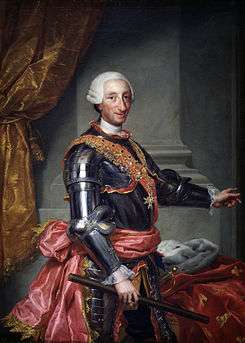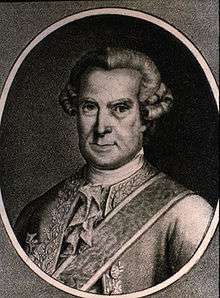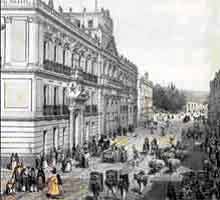Bourbon Reforms
Part of a series on the |
|---|
| History of Spain |
.svg.png) |
| Timeline |
|
|
The Bourbon Reforms (in Castilian: Reformas Borbónicas) were a set of economic and political legislation promulgated by the Spanish Crown under various kings of the House of Bourbon mainly in the 18th century. The strengthening of the crown's power with clear lines of authority to officials contrasted to the complex system of government that evolved under the Hapsburg monarchs.[1] In particular, the crown pursued state supremacy over the Catholic Church, resulting in the suppression of the Society of Jesus in 1767 as well as the attempt to abolish ecclesiastical privilege (fuero eclesiástico).[2]
The reforms resulted in significant restructuring of the administrative structure and the composition of its personnel.[3] The reforms were intended to stimulate manufacturing and technology to modernize Spain. In Spanish America, the reforms were designed to make the administration more efficient and to promote its economic, commercial, and fiscal development. The crown did so, hoping that it would have a positive effect on the economy of Spain. Furthermore, the Bourbon Reforms were intended to limit the power of Creoles and re-establish Spanish supremacy over the colonies.[4]
The reforms achieved mixed results administratively but succeeded in alienating the local elites of the Americas (which called themselves Creoles) and eventually led to the demise of all overseas dominions of the Spanish crown.[5]
End of Habsburg era
At the end of the 17th century, Spain was an ailing empire, facing declining revenues and the loss of military power, ruled by a weak king, Charles II of Spain, who left no successor. Even before his death in 1700, the European powers were already positioning themselves to see the noble house that would succeed in placing its candidate on the Spanish throne and gain its vast empire. Louis XIV of France asked for and received the Pope's consent for his grandson, Philip of Anjou, a great-nephew of Charles, to ascend the throne. On his deathbed, Charles willed the crown to the French-born successor, but an international conflict ensued, the War of the Spanish Succession.
Beginning of Bourbon era
After the war, Spain had to surrender some of its European territories and grant the monopoly of the valuable African slave trade with the Americas to England.[6] Philip V of Spain, the first king of the House of Bourbon, took measures intended to counter the decline of Spanish power. Even before the war, the state of the empire was precarious. When Charles II died, the military was practically nonexistent, consisting of only one division; the treasury was bankrupt; and there was no state promotion of commerce or industry. Philip V and his ministers needed to act quickly to reconstruct the empire.
French Influence
The new Bourbon kings kept close ties with France and used many Frenchmen as advisors. French innovations in politics and social manners never fully replaced Spanish laws and traditions but became an important model in both areas. As a result, there was an influx of French goods, ideas, and books, which helped spread the ideas of the Enlightenment throughout the Spanish world. In a sense, all things French came into fashion during the subsequent century and gave rise to a new type of person, the afrancesado, who welcomed the new influence. In addition, during the War of Succession, the ports in Spanish America were blockaded by British and Dutch fleets. Spain turned to France for help with the export of its goods, which was the first time in Spanish colonial history that trade occurred with a foreign nation. The new commercial relationship stimulated the colonial economy, especially that of Chile.[7]
In Mainland Spain

The early reforms were aimed at improving the economic and political structure of Spain. They sought to modernize agriculture, construction of ships, and infrastructure to monitor and incite economic integration and development on a regional and national level. These reforms unfortunately fell through for Spain. The socio-economic reforms left the country with almost no investment capital. That hindered the nationalization of industries and so disrupted the class system. It left almost no middle class and separated the lower and upper significantly. As a result of the early reforms, the country was dwindling and its progression rate put it behind its neighboring countries such as Great Britain and France.[8]
The failure of reform measures became evident when Spain, under Charles III, lost the Seven Years' War with Great Britain (1756–1763). Charles III's counselors sought more detailed reports of Spain's overseas territories/and now understood the need to take them fully into account. The new wave of reforms included larger exploitation of resources in the colonies, increased taxes, the opening of new ports allowed to trade only with Spain, and the establishment of several state monopolies.
In Spanish America


In Spanish America, José del Campillo y Cosío's Nuevo Sistema de gobierno económico para la América (New System of Economic Government for America) (1743) was a key text that shaped thems. He compared the colonial systems of Britain and France with that of Spain, as the first two nations reaped far greater benefits than Spain. He advocated reforming Spain's economic relations with its overseas territories to a system more like mercantilism of France's Jean-Baptiste Colbert (1619-1683).[9]
The Bourbon reforms have been termed "a revolution in government" for their sweeping changes in the structure of administration that sought to strengthen the power of the Spanish state, decrease the power of local elites in favor of office holders from the Iberian peninsula, and increase revenues for the crown.[10]
The bulk of the changes in Spanish America came in the second half of the 18th century following the visita general (general inspection) of New Spain (1765-1771) by José de Gálvez, who was later named Minister of the Indies. The reforms attempted in New Spain were implemented elsewhere in Spanish America subsequently.[11] There had been one earlier reform in the creation of the new Viceroyalty of New Granada (1717), carved out from the Viceroyalty of Peru to improve the administration of the overseas possessions. The new viceroyalty was created initially in 1717, suppressed just six years later, and finally permanently established in 1739, still earlier than the reforms of the late 18th century. It was an administrative change that reflected the recognition (as early as the 16th century) that the northern area of South America had certain challenges of distance from Peru. There had been earlier creations of captaincies general in Guatemala and Venezuela marking an increase in importance.[12] In 1776, a second jurisdiction, the Viceroyalty of Rio de la Plata was also carved out of the Viceroyalty of Peru in 1776 as part of José de Gálvez's comprehensive administrative reform.[13] In the same year, an autonomous captaincy general was also established in Venezuela.
Under Charles III, colonial matters were concentrated in a single ministry, which took powers away from the Council of the Indies. Furthermore, the advances Americans (Criollos) had made in the local bureaucracy in the past century and a half, usually through the sale of offices, were checked by the direct appointment of (supposedly more qualified and disinterested) Spanish officials.
Charles III also initiated the difficult process of changing the complex administrative system of the former ruling family, the Habsburgs. Corregidores were to be replaced with a French institution, the intendant. The intendancies had the intended effect of further decentralizing the administration at the expense of viceroys, captains general and governors.since intendants were directly responsible to the Crown and were granted large powers in economic and political matters. The intendancy system proved to be efficient in most areas and led to an increase in revenue collection. Intendency seats were mainly based in large cities and successful mining centers. Almost all of the new intendants were Peninsulares, people who were born in Spain, exacerbating the conflict between Peninsulares and Criollos, who wished to retain some control of local administration. Charles III and Charles IV also reversed the advances that Criollos had made in the high courts (audiencias). Under the Habsburgs, the Crown had sold audiencia positions to Criollos. The Bourbon kings ended this policy. By 1807, “only twelve out of ninety-nine [audiencia] judges were creoles.”[14]
With regards to the economy, collection of taxes was more efficient under the intendancy system. In 1778, Charles III established the "Decree of Free Trade," which allowed the Spanish American ports to trade directly with one another and most ports in Spain. Therefore, "commerce would no longer be restricted to four colonial ports (Veracruz, Cartagena, Lima/Callao, and Panama)."[15] Tax reductions were given to the silver mining industry. Tobacco proved to be a successful crop after state monopolies were expanded. Also, many of the colonies began to produce an abundance of resouthat, which became vital to many European powers and the British colonies in North America and the Caribbean despite the fact that most of this trade was considered contraband since it was not carried on Spanish ships. Most of the Bourbon kings tried to outlaw this trade through various programs like increasing the customs receipts, with little avail.[16]
Spanish America barely had an operational military before the Bourbon reforms, and what it had was inconsistent and scattered. The Bourbons created a more organized militia and first used men deployed straight from Spain as officers, but soon that broke down, as locals took most positions. The colonial militias became a source of prestige for status-hungry Criollos. The hierarchy of the military was racially based. Militias were often created along race lines, with militias for whites, blacks and mixed race people. Almost all the higher officers were Spanish-born, with Criollos occupying the secondary levels of command.
The Bourbons also made the government more secular. The political role of the Church was diminished but never removed completely. Unlike the Habsburgs, who often selected churchmen to fill political offices, the Bourbons preferred to appoint career military officers. The process reached a high point with the Suppression of the Society of Jesus in 1767. The Jesuits were one of the wealthiest religious orders and had been instrumental in the missionary work carried out in the Americas and the Philippines. Because they had major rivals in the other orders of the church, their dismissal was greeted with covert approval. The crown also tried to place the more secular clergy in the church hierarchy, reversing a trend since the beginning of the colonial period of having the regular clergy fill these posts. Overall, these changes had little effect on the Church as a whole. Towards the end of the Bourbon reign, on the "eve of independence, the crown attempted to confiscate church property, but the measure proved hard to enforce."[17]
Effects
Though the legislation passed by the Bourbons did much to reform the Empire, it was not enough to save it. The racial tensions continued to grow and there was still massive discontent, the most important of which were the Rebellion of Túpac Amaru II and Revolt of the Comuneros. The discontent led many people to unite and lead several revolts. Criollos, Mestizos, and Indians were among the most common to be involved in such resistance movements.[18] Over time, these uprisings led to the fight for the independence of the American colonies.
See also
- Enlightenment in Spain
- Spanish American Enlightenment
- Historiography of Colonial Spanish America
- Nueva Planta decrees issued by Philip V, 1707-1716, reorganizing the royal government of Spain
References
In Spanish unless otherwise noted.
- ↑ James Lockhart and Stuart B. Schwartz, Early Latin America. New York: Cambridge University Press 1983, p. 347.
- ↑ N.M. Farriss, Crown and Clergy in Colonial Mexico. London: Athlone 1968.
- ↑ James Lockhart and Stuart Schwartz, Early Latin America. Cambridge: Cambridge University Press 1983, p. 347.
- ↑ Ortega Noriega, Sergio. "Las reformas borbónicas y la Independencia, 1767-1821" Archived November 25, 2005, at the Wayback Machine., Breve historia de Sinaloa. Mexico, 1999. ISBN 968-16-5378-5
- ↑ "The Bourbon Reforms" Archived October 26, 2015, at the Wayback Machine.
- ↑ Hill: Robert Harley, 162–5; Wolf: Louis XIV, 581; Pitt: The Pacification of Utrecht, 460; Trevelyan: England, III, 182–5
- ↑ Skidmore, Thomas E. and Peter H. Smith. Modern Latin America. Oxford: Oxford University Press, 2005.
- ↑ "Memoria chilena" Archived March 12, 2007, at the Wayback Machine.. Las reformas borbónicas (1700–1788).
- ↑ D.A. Brading, Miners and Merchants in Bourbon Mexico, 1763-1810. Cambridge: Cambridge University Press 1971, p. 27.
- ↑ Brading, Miners and Merchants in Bourbon Mexico, pp. 33-94.
- ↑ Brading, Miners and Merchants in Bourbon Mexico, p. 34.
- ↑ James Lockhart and Stuart Schwartz, Early Latin America. Cambridge: Cambridge University Press 1983, p. 348.
- ↑ "Reformas Borbónicas en el Virreinato del Río de la Plata" Historia Argentina-Planeta Senda.
- ↑ Burns, E. Bradford and Julie A. Charlip. Latin America: An Interpretative History. Upper Saddle River, New Jersey: Pearson Education Inc., 2007.
- ↑ Merrill, Tim L. and Ramón Miró, editors. "Road to Independence", Mexico: A Country Study. Washington: GPO for the Library of Congress, 1996.
- ↑ "History of Latin America". Encyclopædia Britannica Presents Hispanic Heritage in the Americas.
- ↑ Crow, John A. The Epic of Latin America. Berkeley: University of California Press, 1980.
- ↑ Gómez Alarcón, Arturo. "Las Reformas Borbónicas en el Perú" Archived October 28, 2005, at the Wayback Machine.. 2005, Historiaperu.bitacoras.com.
Bibliography
Economy
- Brading, D. A. Haciendas and Ranchos in the Mexican Bajío: León, 1700-1860. Cambridge, 1978. ISBN 978-0-521-22200-6
- Brading, D. A. Miners and Merchants in Bourbon Mexico, 1763-1810. Cambridge, Cambridge University Press, 1971. ISBN 978-0-521-07874-0
- Buechler, Rose Marie. The Mining Society of Potosí, 1776-1810. Ann Arbor, Syracuse University, 1981. ISBN 978-0-8357-0591-2
- Deans-Smith, Susan. Bureaucrats, Planters, and Workers: The Making of the Tobacco Monopoly in Bourbon Mexico. Austin, University of Texas Press, 1992. ISBN 978-0-292-70786-3
- Fisher, John R. Commercial Relations between Spain and Spanish America in the Era of Free Trade, 1778-1796. Liverpool, University of Liverpool, 1985. ISBN 978-0-902806-12-2
- Fisher, John R. Silver Mines and Silver Miners in Colonial Peru, 1776-1824. Liverpool, 1977. ISBN 978-0-902806-06-1
- Fisher, John R. Trade, War, and Revolution: Exports from Spain to Spanish America, 1797-1820. Liverpool, University of Liverpool, 1992. ISBN 978-0-902806-22-1
- Liss, Peggy K. Atlantic Empires: The Network of Trade and Revolution, 1713-1826. Baltimore, 1983. ISBN 978-0-8018-2742-6
- Ringrose, David. Spain, Europe and the "Spanish Miracle," 1700-1900. Cambridge, Cambridge University Press, 1996. ISBN 978-0-585-04069-1
- Socolow, Susan Migden. The Merchants of Buenos Aires, 1778-1810: Family and Commerce. Cambridge 1978. ISBN 978-0-521-21812-2
- Van Young, Eric. Hacienda and Market in Eighteenth Century Mexico: The Rural Economy of Guadalajara, 1675-1820. Berkeley, 1981. ISBN 978-0-520-04161-5
Government
- Andrien, Kenneth J. The Kingdom of Quito, 1690-1830: The State and Regional Development. Cambridge, Cambridge University Press, 1995. ISBN 978-0-521-48125-0
- Barbier, Jacques A. Reform and Politics in Bourbon Chile, 1755-1796. Ottawa, University of Ottawa Press, 1980. ISBN 978-2-7603-5010-6
- Brown, Kendall W. Bourbons and Brandy: Imperial Reform in Eighteenth-Century Arequipa. Albuquerque, University of New Mexico Press, 1986. ISBN 978-0-8263-0829-0
- Burkholder, Mark A. and D. S. Chandler. From Impotence to Authority: The Spanish Crown and the American Audiencias, 1687-1808. Columbus, University of Missouri Press, 1977. ISBN 978-0-8262-0219-2
- Fisher, John R. Government and Society in Colonial Peru: The Intendant System, 1784-1814. London, Athlone Press, 1970. ISBN 978-0-485-13129-1
- Fisher, Lillian Estelle. The Intendant System in Spanish America. Berkeley, University of California Press, 1929.
- Floyd, Troy S. (ed.). The Bourbon Reformers and Spanish Civilization; Builders or Destroyers? Boston: Heath, 1966.
- Hamnett, Brian R. Politics and Trade in Southern Mexico, 1750-1821. Cambridge, Cambridge University Press, 1971. ISBN 978-0-521-07860-3
- Lynch, John.. Spanish Colonial Administration, 1782-1810: The Intendant System in the Viceroyalty of the Río de la Plata. London, Athlone Press, 1958.
- McFarlane, Anthony. Colombia before Independence: Economy, Society, and Politics under Bourbon Rule. Cambridge, Cambridge University Press, 1993. ISBN 978-0-521-41641-2
- McKinley, P. Michael. Pre-Revolutionary Caracas: Politics, Economy, and Society, 1777-1811. Cambridge Cambridge University Press, 1985. ISBN 978-0-521-30450-4
Military
- Archer, Christon I. The Army in Bourbon Mexico, 1760-1810. Albuquerque, University of New Mexico Press, 1977. ISBN 978-0-8263-0442-1
- Campbell, Leon G. The Military and Society in Colonial Peru, 1750-1810. Philadelphia, American Philosophical Society, 1978. ISBN 978-0-87169-123-1
- Kuethe, Allan J. Military Reform and Society in New Granada, 1773-1808. Gainesville, University of Florida Press, 1978. ISBN 978-0-8130-0570-6
- Kuethe, Allan J. Cuba, 1753-1815: Crown, Military and Society. Knoxville, University of Tennessee Press, 1986. ISBN 978-0-87049-487-1
Society
- Brading, D. A. Church and State in Bourbon Mexico: The Diocese of Michoacán, 1749-1810. Cambridge, Cambridge University Press, 1994. ISBN 978-0-521-46092-7
- Farris, Nancy M. Crown and Clergy in Colonial Mexico, 1759-1821: The Crisis of Ecclesiastical Privilege. London, Athlone Press, 1968. ISBN 978-0-485-13121-5
- Ladd, Doris M. The Mexican Nobility at Independence, 1780-1826. Austin, 1976. ISBN 978-0-292-75027-2
- Seed, Patricia. To Love Honor and Obey in Colonial Mexico: Conflicts Over Marriage Choice, 1574-1821. Stanford, Stanford University Press, 1988. ISBN 978-0-8047-1457-0
- Premo, Bianca, "Children of the Father King: Youth, Authority and Legal Minority in Colonial Lima," Chapel Hill, University of North Carolina Press, 2005 IBSN 978-0-8078-5619-2
